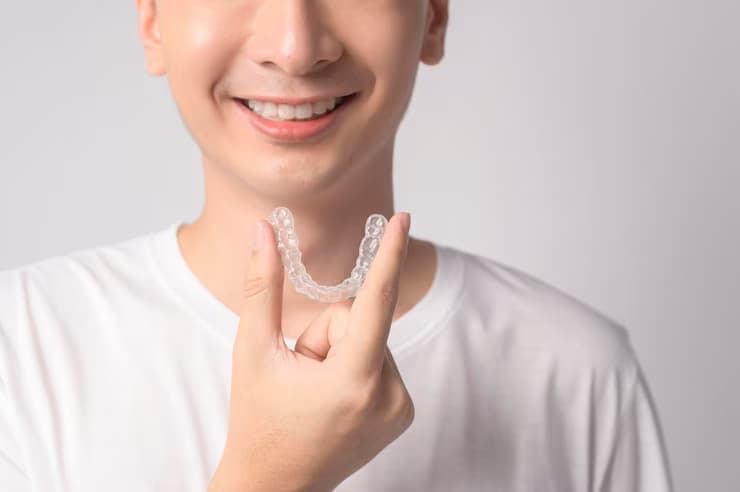When it comes to improving your smile without metal braces, Invisalign has become a popular choice. Many people ask the same question at the beginning of their journey: How long does Invisalign take? As dental professionals, we help patients understand the treatment process and what to expect from start to finish. At CITIDENTAL Brookline, we carefully plan your treatment to ensure you achieve the results you’re looking for. Here’s a complete look at the Invisalign experience—from the first visit to the final retainer. Understanding Invisalign: A Quick Overview What Is Invisalign? Invisalign is a system of clear aligners designed to straighten teeth. Crafted from a smooth, flexible material, these aligners are custom-made for a comfortable fit. They’re almost invisible, which means you can go through treatment without drawing attention to your smile. Invisalign slowly moves your teeth into their ideal position over time. You’ll use a series of aligners, each set gently shifting your teeth toward better alignment. Depending on your treatment plan, you’ll change to a new aligner every one to two weeks. How It Works Compared to Traditional Braces Unlike traditional metal braces, Invisalign uses clear aligners instead of brackets and wires. That means no food restrictions, no wires poking your cheeks, and no need for frequent visits to tighten anything. The aligners are removable, allowing you to eat, brush, and floss just as you normally would. This makes Invisalign a more comfortable and flexible option for many patients. Why Choose an Invisalign Dentist? Choosing a dentist with experience in Invisalign is important. Our team at CITIDENTAL Brookline is trained to create custom Invisalign plans for a wide range of alignment needs. We use advanced digital imaging to plan your treatment from beginning to end. That allows us to predict how your smile will look and ensure the process is smooth and effective. Average Invisalign Treatment Timeline General Duration of Treatment Invisalign treatment typically lasts between 6 and 18 months, though this can vary. If you have minor spacing issues, treatment may take about 6 months, while more complex cases may require up to 18 months or longer. Factors That Can Affect the Timeline There are several factors that can influence the duration of your Invisalign treatment: Short vs. Long Treatment Cases Short cases might include simple crowding or spacing. In certain cases, these issues can be addressed in under a year. Longer cases often involve rotated teeth, bite problems, or other orthodontic concerns. We review every case in detail to set a realistic timeline and make sure your goals are achievable. What to Expect During the Invisalign Journey Initial Consultation With an Invisalign Dentist Your journey begins with a consultation. During this appointment, we capture digital scans of your teeth and evaluate if Invisalign is the right option for you. We guide you through every step of the process and answer any questions along the way. If Invisalign suits your needs, we’ll develop a customized treatment plan tailored to your specific goals. Getting Your Custom Aligners After finalizing your plan, your aligners will be custom-made to perfectly fit your teeth. You’ll get your first set along with clear instructions on how to wear and care for them. Each aligner is unique, crafted to gently move your teeth into the desired position over time. You will wear each aligner for one to two weeks before moving on to the next in the series. Following the schedule we give you is crucial to keep your treatment progressing smoothly. Monitoring Progress and Adjustments We schedule check-ins every few weeks to monitor your progress. These appointments allow us to see how your teeth are moving and make sure everything is going as planned. In some cases, we might adjust your treatment schedule or provide additional aligners to help perfect your results. The Role of Compliance in Invisalign Success Daily Wear Time Requirements Wearing your aligners consistently is key to success. Keep them on for 20 to 22 hours daily, taking them out only when you eat, drink, brush, or floss. If they’re not worn as recommended, the treatment may take longer or not produce the expected results. What Happens If You Don’t Wear Aligners Consistently? Failing to wear the aligners as directed may cause your teeth to shift slower or not follow the intended progression. This could cause delays, discomfort, or require extra aligners. Following your plan and wearing your aligners every day ensures your Invisalign dental treatment stays on schedule. Invisalign for Teens vs. Adults Age-Based Differences in Treatment Length Invisalign works well for both teens and adults, but there can be some differences in how long treatment takes. Teens’ teeth may move more easily, which can shorten the overall timeline. However, with good habits, adults can achieve the same results in a similar timeframe. Tailored Treatment Plans for Every Smile At our office, we customize each Invisalign dental treatment based on the patient’s needs. Whether you’re a teen or an adult, we create a plan that fits your goals and lifestyle. Everyone deserves a confident smile, and Invisalign can help make that possible. Final Results and Life After Invisalign Using Retainers After Treatment Once your teeth are in their new position, you’ll need to wear a retainer. Retainers help maintain your results by keeping your teeth from shifting back. We usually recommend wearing them at night, but the schedule may vary based on your specific case. Maintaining Your New Smile Keeping your new smile means continuing good oral habits. Brush and floss daily, visit us for routine cleanings, and wear your retainer as advised. With these simple steps, your results can last a lifetime. How an Invisalign Dentist Supports You Long-Term Even after treatment ends, we’re here to help you maintain your smile. We schedule follow-up visits to check on your progress and ensure your retainers are still fitting well. Our team provides long-term support so you feel confident in your smile for years to come. Is Invisalign Right for You? Conditions Invisalign Can Treat Invisalign can correct

